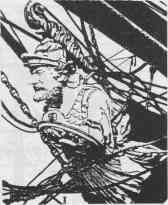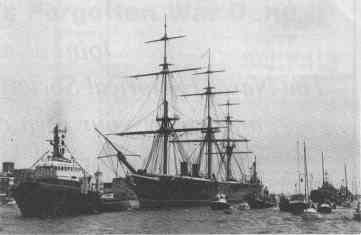- Author
- Periodical, Australian Shipyards
- Subjects
- History - general, Ship histories and stories
- Tags
-
- RAN Ships
- None noted.
- Publication
- June 1990 edition of the Naval Historical Review (all rights reserved)
Replacement of the timber deck posed a problem until a Trust member discovered a wool store being demolished. All five floors were laid with 9 inch by 3 inch thick Finnish Redwood. This was purchased for £10,000.
Repairs to the deck and replanking was completed in early 1983. Timber for hatchway coamings, giant 12 inch by 12 inch baulks of Pitch Pine, was also obtained from the wool store. This was adzed in situ and secured. A team of elderly tradesmen were recruited in Hartlepool to caulk and pay the seams.
The hull of the ship was sound and no water entered the vessel but the lower decks and bulkheads were badly corroded. The worst areas were replaced with welded steel sheets.
Estimates had by this time risen to £6 million and the Trust maintained continuous appeals for funds. A special appeal was launched for the ship’s armament. Replicas in fibreglass of the WARRIOR’S great 110 pounders cost £3,000 each.
Meanwhile work commenced on the ship’s three massive masts and yards. These were timber in the original fitting but the replacements were made of fabricated steel. The first to be stepped was the smallest, the 153 foot mizzen. By mid 1985 the WARRIOR was assuming her former glory.
The wide spanning yards were hoisted into position. Steel wire rope replaced the original ironwire rigging and polyproplene nylon was substituted for the tarred Italian hemp. Duralon canvas sails were furled on the yards. Nylon hammock nettings were laced along the bulwarks.
From eight in 1979 the permanent workforce engaged in the restoration had grown to 150 and these were supported by a force of volunteers which exceeded 450. A special team of volunteer draftsmen produced more than 500 new drawings and reproduced many more which were still held in records.

The ship’s finely curved beak, bowsprit and figurehead had been carried away in a berthing collision at Llanion. A new beak and bowsprit were fitted in 1984 and the replacement figurehead of a Roman warrior in full armament was carved from three tons of Yellow Pine by Isle of Wight woodcarvers Jack Whitehead and Norman Gaches. It was secured in place in February, 1985.
One of the most difficult tasks to confront the restoration team was the manufacture of WARRIOR’S engines and boilers. Although it was not intended the engines should steam it was agreed they should be accurate replicas capable of turning. The Penn engine itself was 13 foot high and the crankshaft some 30 foot long. Access to the compartments was by hatches 8 foot high by 4 foot wide. Each of the engines cylinders was 112 inches in diameter.
The team for this task was led by Mr J. Wilson. Their work was so realistic that it was difficult to identify them as replicas.
Ship Joiners reproduced the officers’ and lower deck accommodation and the bridge. They also undertook the task of manufacturing the four great wooden wheels which steered the ship.
The ship’s boats, davits, anchors and a thousand other items in the original equipment of WARRIOR were built in the workshops or by specialist contractors.
A large proportion of the painting in the ship was carried out by squads of volunteers under the superintendence of retired naval personnel. It was estimated that cleaning back the old paint required the removal of 100 coats.
On June 12, 1987 when WARRIOR left Hartlepool under tow for Portsmouth the ship was 95 per cent complete. Throughout the 390 mile voyage several hundred volunteers worked to complete tasks.
WARRIOR arrived off Portsmouth on 26 June and was warped into the specially deepened berth prepared for her. She was secured in the company of Henry VIII’s MARY ROSE and Nelson’s VICTORY – illustrious company for the Royal Navy’s first and last battleship. She was opened for public inspection on 27 July.
No one has yet arrived at the total cost of the ships restoration. The £6 million of 1985 had been exceeded by £4 million but no estimate has been made of the voluntary labour which also contributed to her completion.





